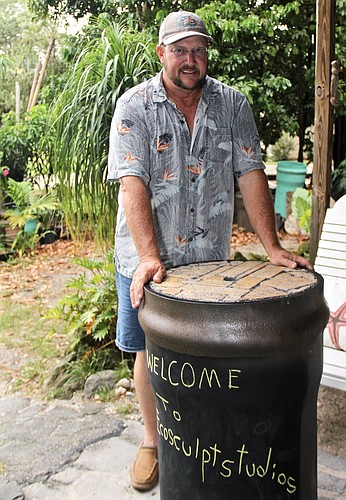- December 18, 2025
-
-
Loading

Loading

For years, Joe Bryant watched as leftover construction materials were hauled off to landfills.
Pieces of industrial pipes. Chunks of rock. Glass. Every week, Dumpster after Dumpster was filled with material the crews couldn’t use.
As an inspector for construction sites, Bryant has seen hundreds of Dumpsters filled and hauled away. But because these materials are built to withstand the elements, they aren’t exactly biodegradable. Instead, they just sit in the landfills, Bryant said.
Then, nearly two years ago, he had an idea. He took home a section of piping destined for the garbage and, after some experimentation, managed to transform the pipe into usable furniture.
Now, he’s all-in on collecting construction scraps for his new side-business called EcoSculpt Studios. It’s functional, industrial art, he said.
“It’s amazing what we throw away, and they’re good materials that we’re throwing away,” Bryant said.
A single pipe can be transformed into a pedestal, a side table, a stool or, in the case of larger pieces, a high-top table. A single project can often take nearly 30 hours to complete. For Bryant, creating each piece is an art form.
“It’s a labor of love,” Bryant said.
To start, Bryant chooses a pipe according to what the customer requested. Then comes the tedious process of sanding the bottom until the pipe stands on its end without wobbling.
“It’s about getting them level and making them user-friendly so they aren’t going to tip over,” Bryant said.
Once the bottom is level, Bryant fills the top hole of the pipe with a lightweight concrete that uses recycled Styrofoam peanuts, sand and pumice stone.
“I didn’t want to just buy the concrete,” Bryant said of using recycled materials in his homemade concrete. “That kind of would defeat the purpose of what I’m doing.”
The final stage is inlaying the top with stone, which are chunks of unused stone from countertops, and giving the transformed pipe a coat of paint.
“The art of it is really puzzling the pieces together (for the top) and picking out the right paint,” Bryant said.
And he always lets customers assist in the creative process.
“My favorite thing to do is when someone wants some thing custom,” Bryant said. “They can do as much as they want or as little as they want.”
Many of his pieces also include a glass panel in the center of the tabletop. He places a small light underneath the glass to illuminate the tabletop. In the case of a pedestal, the illuminated glass is a good way to display a piece of artwork, Bryant said.
When he’s at work, Bryant is always on the lookout for interesting pipes to throw into his truck to take home and regularly stops at a countertop warehouse to collect chunks of stone. A stash of pipes and rock has been accumulating in his back yard for the last year. He has several completed pieces in and around his home, and has discovered that his furniture is entirely weather-proof and storm-proof.
“The nice thing about these is that you can put them outside, and they’re fine,” Bryant said. “They’re really forever tables. You’re going to be giving them to your kids; they’ll last that long.”
The reception from customers has been positive he said, and he’s almost always working on a project.
It’s the eco-friendly factor that people seem to like best.
“Just about everybody likes the idea of recycling,” Bryant said. “So, I feel that I’m doing my part.”
Contact Brittany Gaines at [email protected].